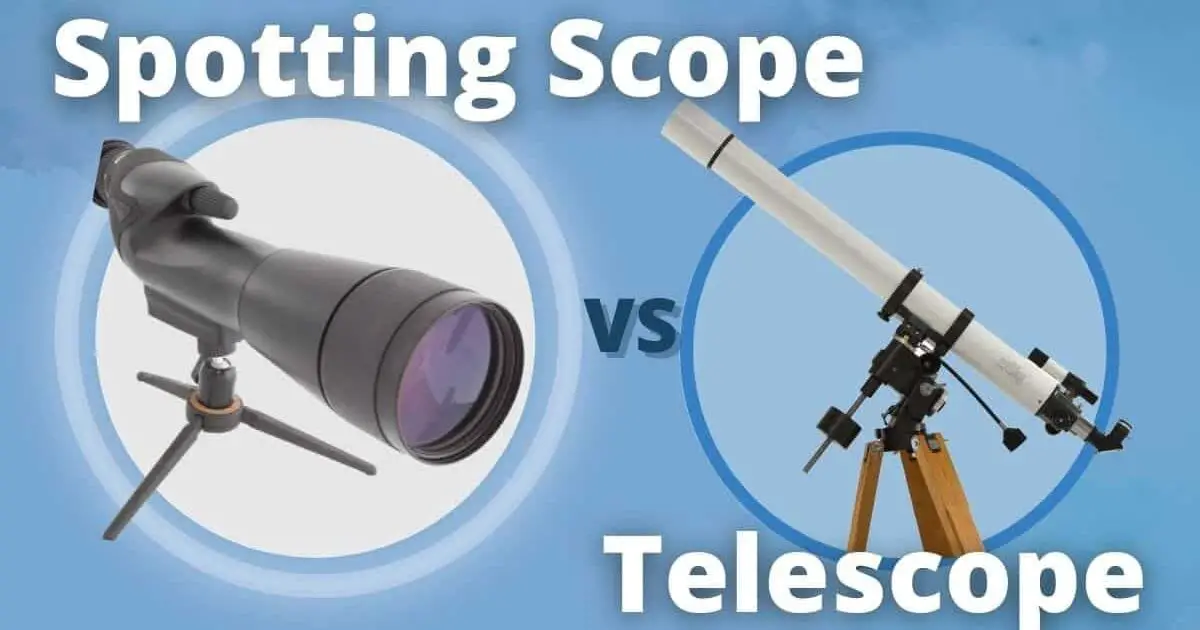Nature spotting scopes are used for terrestrial or marine viewing. Can they double for astronomy use? Yes, is the answer, but with limitations. In this article, I discuss the pros and cons of using a nature spotting scope vs astronomy telescope as an instrument for looking at objects, high in the sky.

Key takeaway for spotting vs astronomy telescope:
* Spotting scopes can be used in astronomy
* Some are awkward for looking upward at objects in the sky
* They magnify similar to a small telescope; okay for Moon and some planets
* They are lightweight and compact — similar benefits to using binoculars
Spotting scope vs astronomy telescope
One basic type of spotting scope is a straight-through design, with the eyepiece at one end, and the objective lens at the other. This type is a refractor and is not too unlike the refractors found in astronomy.
Angled spotting scopes, like the one shown below, have the eyepiece end raised 45º.
Spotting scopes are designed for looking downwards, at the same level, or up to shallow angles skywards. Whereas, astronomy telescopes are designed for looking upward at the sky. (You can attach spotting scopes to a suitable tripod to aid direction and positioning.)

Vortex Optics Diamondback HD Spotting Scopes
available at Amazon (affiliate link)
Magnification
A spotting scope is built for land or marine viewing. It’s suited to daytime observations of nature at a distance that’s relatively close compared to the huge expanse involved with observing celestial bodies.
The spotting scope range of magnification can be up to 60x (look for the numbers before the ‘x’ in the style name; e.g. 20-60x). Though useful for looking at the Moon and maybe Jupiter and Saturn, on the whole, spotting scopes are limited in magnifying power to make the most ideal astronomical telescopes.
(The number following the ‘x’ is usually the objective lens size.)
If your primary use for a scope is astronomy, it’s probably better to get a telescope rather than a spotting scope (see what to look for in a telescope for astronomy).
Field of view
I wrote about the amount of sky you see through different means in my article covering field of view in astronomy…

Spotting scopes, like binoculars, have a field of view expressed as a linear measure of width (i.e., feet @ 1000 yds). Using the divisor of 52.5 conversion method (where at 1000 yards, one degree is 52.5 feet):
- 85mm spotting scope with FOV of 108 – 60 ft@1000 yds = 2°–1.4°
- 65mm spotting scope with FOV of 138–72 ft@1000 yds = 2.6°–1.4°
Going by these figures, you’ll see more of the sky with a spotting scope than you would through a telescope, but not as wide a view as you would with a set of binoculars.
To understand the scope of the sky in a given number of degrees, see my article on measuring the sky using your hand.
Pros and Cons of using a spotting scope vs astronomy telescope
They can be good in backyard astronomy, but you have to consider the cons as well:
Pros
- A spotting scope is a light, compact device, which is a big advantage for those who want an instrument they can take with them when they’re on the go.
- They are portable to take on hikes or trips, similar to binoculars.
- Top rated ones are waterproof, preventing moisture from the likes of fog and mist entering the internals.
- They can be used without a tripod if you can stabilize them another way so there’s no setting up involved.
- They offer a wider view of the sky compared to a telescope
Cons
- Awkward to use when looking high in the sky
- Limited magnification compared to telescopes for seeing details of planets
- Spotting scopes don’t usually have optical quality of an astronomical telescope
- May not offer the advantages in optics, coatings, or high quality glass of an astronomical telescope for the same price
- Images may have aberrations around the edges of objects
- You can’t modify them by swapping out eyepieces or adding filters etc.
How to use a spotting scope for astronomy
The first step is stabilizing it. You could look to invest in a taller more robust tripod than the original or try some other form of steadying the scope while looking skywards.
Apart from the tripod idea, you could get close to the ground and secure a steady hold using support not unlike using a set of binoculars for sky viewing. I explain ways in my article on holding astronomy binoculars steady.
- The angled spotting scope is said to work better than the straight-through configuration for sky viewing, but that could be a matter of preference.
The next step is to have an aperture large enough for decent light-gathering. A spotting scope with an aperture of say 70mm, or at least a 65mm aperture, would fit best and allow some basic astronomical use.
Then, it’s about the quality of the images. With extra low-dispersion glass (ED glass), you may get better and clearer views.
Summing up using spotting scopes for astronomy
You can use nature spotting scopes for astronomy, but they may not give you the pleasure you’d from using a decent astronomical telescope.
If you want a scope that lets you view animals and plants close up, but only on occasion, scan the night skies, then a good quality spotting scope is probably your best pick.
There are, of course, telescope types that can be used for both land and stars. This is one area where refractors, vs reflectors, can have an advantage.
FAQs
Reference material
- Dickinson, T. 2019. NightWatch: A Practical Guide to Viewing the Universe (affiliate link). Firefly Books.
- Hunting Optics on spotting scopes for astronomy
